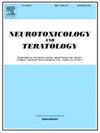Prenatal tobacco and tobacco-Cannabis co-exposure and unpredictability in maternal anger/hostility: Implications for toddler reactivity
IF 2.8
3区 医学
Q3 NEUROSCIENCES
引用次数: 0
Abstract
Tobacco and cannabis are frequently used together during pregnancy. However, relatively little is known about how co-use and related maternal risk factors impact toddler reactivity. One understudied risk factor is maternal experience of anger/hostility, despite evidence suggesting that individuals who use substances experience more anger/hostility. In addition, mood unpredictability in anger/hostility (MUA), a relatively novel construct, may be particularly important for mothers who use substances as they attempt to cut down or quit during pregnancy and may also impact toddler reactivity. Importantly, prenatal exposures may also impact toddler outcomes via continued postnatal exposure and infant reactivity. We examined a conceptual model linking prenatal tobacco and tobacco-cannabis co-use, maternal anger/hostility, and unpredictability in anger/hostility with toddler reactivity in a sample (N = 247 at recruitment, 190 at toddler age; N = 247 for model testing) of dyads recruited during the first trimester of pregnancy into a tobacco group (use of combustible cigarettes; including sub-group of women who also used cannabis) and a non-substance use group. Results indicated a direct effect of prenatal co-exposure on blunted toddler reactivity for males only. Mothers who used substances prenatally had the highest levels of anger/hostility and MUA. Prenatal anger/hostility and MUA were associated with higher reactivity at infancy which in turn, was associated with higher toddler reactivity. Prenatal co-exposure and higher prenatal maternal anger/hostility was associated with continued postnatal exposure to cannabis which in turn, was associated with higher reactivity at toddlerhood. Results highlight the importance of examining prenatal co-exposure and continued postnatal cannabis exposure as well as associated maternal risk factors such as anger/hostility and MUA for toddler developmental outcomes.
产前烟草和烟草大麻共同暴露与母亲愤怒/敌意的不可预测性:对幼儿反应的影响。
孕期经常同时使用烟草和大麻。然而,人们对同时使用和相关的孕产妇风险因素如何影响幼儿的反应却知之甚少。其中一个未被充分研究的风险因素是母亲的愤怒/敌意经历,尽管有证据表明使用药物的人经历更多的愤怒/敌意。此外,愤怒/敌意情绪的不可预测性(MUA)是一个相对新颖的概念,可能对使用药物的母亲在怀孕期间试图减少或戒除药物尤为重要,也可能影响幼儿的反应性。重要的是,产前暴露也可能通过产后持续暴露和婴儿反应影响幼儿的结果。我们研究了一个概念模型,该模型将产前烟草和烟草大麻共用、母亲的愤怒/敌意以及愤怒/敌意的不可预测性与幼儿的反应性联系在一起,研究对象是在怀孕前三个月被招募到烟草组(使用可燃卷烟;包括同时使用大麻的女性子组)和非药物使用组的二人组样本(招募时的样本数=247,幼儿年龄时的样本数=190;用于模型测试的样本数=247)。结果表明,产前共同接触对幼儿反应迟钝有直接影响的只有男性。产前使用药物的母亲的愤怒/敌意和MUA水平最高。产前的愤怒/敌意和MUA与婴儿期较高的反应性有关,而婴儿期较高的反应性又与幼儿较高的反应性有关。产前共同暴露和产前母亲较高的愤怒/敌意与产后持续暴露于大麻有关,而这又与幼儿期较高的反应性有关。研究结果凸显了研究产前共同暴露和产后持续接触大麻以及相关的母亲风险因素(如愤怒/敌意和畸形儿)对幼儿发育结果的重要性。
本文章由计算机程序翻译,如有差异,请以英文原文为准。
求助全文
约1分钟内获得全文
求助全文
来源期刊
CiteScore
5.60
自引率
10.30%
发文量
48
审稿时长
58 days
期刊介绍:
Neurotoxicology and Teratology provides a forum for publishing new information regarding the effects of chemical and physical agents on the developing, adult or aging nervous system. In this context, the fields of neurotoxicology and teratology include studies of agent-induced alterations of nervous system function, with a focus on behavioral outcomes and their underlying physiological and neurochemical mechanisms. The Journal publishes original, peer-reviewed Research Reports of experimental, clinical, and epidemiological studies that address the neurotoxicity and/or functional teratology of pesticides, solvents, heavy metals, nanomaterials, organometals, industrial compounds, mixtures, drugs of abuse, pharmaceuticals, animal and plant toxins, atmospheric reaction products, and physical agents such as radiation and noise. These reports include traditional mammalian neurotoxicology experiments, human studies, studies using non-mammalian animal models, and mechanistic studies in vivo or in vitro. Special Issues, Reviews, Commentaries, Meeting Reports, and Symposium Papers provide timely updates on areas that have reached a critical point of synthesis, on aspects of a scientific field undergoing rapid change, or on areas that present special methodological or interpretive problems. Theoretical Articles address concepts and potential mechanisms underlying actions of agents of interest in the nervous system. The Journal also publishes Brief Communications that concisely describe a new method, technique, apparatus, or experimental result.

 求助内容:
求助内容: 应助结果提醒方式:
应助结果提醒方式:


